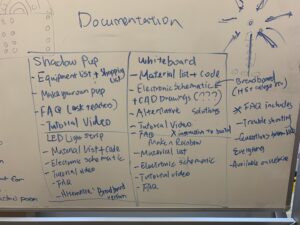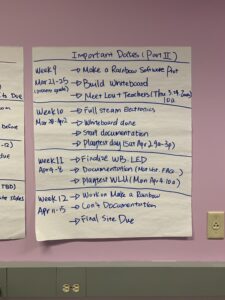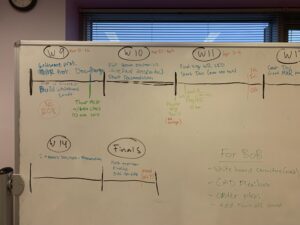Introduction
This week we focused on fabricating the hardware as well as further developing our current prototypes. We have faced some challenges during the process, and made adjustments accordingly. The team also playtested at Assemble on Thursday, Mar 17 with prototypes that had new features. On Friday, the team met with our faculty consultant Mo Mahler who gave us both positive and constructive feedback. We then had a meeting to discuss our future plans regarding deliverables, design and scope.
Tech Updates – Learn from Failure (and Success)
Whiteboard Activity
- Bob has started fabricating the whiteboard activity. We are using a larger whiteboard that covers the entire surface.
- We are also replacing the switches from the original prototype to latching buttons a the control for the DMX light.

Slider Activity
For this activity, we had a software prototype that we have tested. Our goal was to make it into a hardware prototype that includes 6 slides and numerous short LED strips. This activity seems simple and straightforward, however, to actually build it, transferring it from software to hardware was harder than we expected.
Initially, we had one side of the activity working. That was a good sign. As we were adding more sliders and more lights, we realized the amount of wires and parts that would go in would make it hard to fabricate, maintain and replicate. After discussing it with our client on Friday, the team has decided to not to further pursue this activity in hardware form. We will still have the software version available as a supplementary material for other activities.
There are several reasons that went into this decision making:
- This activity is not designed to be a standalone activity. It’s supplementary to other activities. Kids are generally not super excited about it. The team thinks it acceptable to let it exist in the software form
- Spending too much time on fabricating this activity would cut the time that could be spent on further developing other activities that have more depth to it. It is simply out of our scope to fabricate everything into hardware
- Our client has agreed that this is a good move.


Software activities
- Caitlyn has built the software version of Make a Rainbow activity to replace color matching activity
- This is a link for anyone that’s interested in playing.
Playtest at Assemble
The playtest at Assemble went very well. We arrived there at 5pm on Thursday, March 17 with 3 activities: shadow puppets, the LED light strip with sound and software activities, including Caitlyn’s new “Make A Rainbow” prototype. It was mostly an open, freeplay environment. There were 9 Grade 2 kids in total. 6 of them participated in our activity. Among the 3 boys who didn’t participate, one of them wanted to try, but his two friends were not as interested, so they ended up playing by themselves.

LED Light strip
The Light Strip we brought has a new feature: each color has a music note assigned to it. When you finish the whole light strip, you can hear the music notes being played back. We printed out some light combinations that made the light strip play back songs such as Mary Has a Little Lamb and Ode to Joy.
We observed that kids were really drawn into this activity by the sound. They wanted to make their own song. The light combinations that we printed out also brought some surprises to kids and inspired them to create their own music. The replayability and the engagement of this activity are enhanced by the sound. One kid was also very drawn to the button pressing. She said she wanted her house to have doors that you can only unlock with the correct button pressing.
We wanted to know the teachers’ opinions on the sound. One of the teachers at Assemble liked the sound. She said the sound could be especially helpful for visually impared kids. She also suggested that we could add a switch that turns on and off the sound system.


Shadow puppet
We made some more shadow puppets that are of different types. Some of them have colored gels on them.
Kids were very engaged with this activity. Even before we arrived, the teachers at Assemble guided the kids to build their own shadow puppets. After we set up, the kids tested their own puppets and also played with the puppets that we brought. We learned that some kids have learned primary and secondary colors already. The boys also came to play very briefly. Similar to the playtest at WLU, the boys really liked to dance in front of the lights.


Software activities
We brought the Make a Rainbow and the slider activities.. Sliders had about the same reaction that we saw during other playtests. Enjoyable, but not something that was replayed more than a few times. Make-A-Rainbow was a hit. Kids loved mixing the colors to try to get new ones. Kids asked questions out of curiosity rather than confusion. Some kids came back to replay even after leaving to do other things.


Meeting with Consultant
On Friday we met our faculty consultant, Mo Mahler. Mo liked our activities overall. He thinks that our light strip activity has more replayability and depth to it. However, he suggested we further explore the Make a Rainbow activity, either bringing in a narrative or introducing other challenges. He also led a brainstorming session.
Next week we are going to
- Build whiteboard activity
- Meet with teachers at WLU to discuss documentation
- Start hardware prototyping make a rainbow activity
Elevator Pitch Video
We have made an elevator pitch video that’s also available on our media page.



